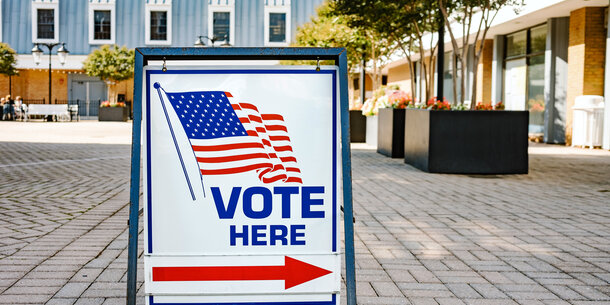In key respects, the 2020 elections demonstrated the strength and resilience of America’s electoral system. Voter turnout smashed records in almost every state, and despite unprecedented challenges from the pandemic, we did not suffer an election administration catastrophe. 1 Opponents of voting rights suggest that these successes mean that voting barriers are no longer a significant concern and that our country has moved past the era of voter suppression. 2 However, a closer look into turnout numbers reveals persistent and troubling racial disparities that are due in part to racial discrimination in the voting process. And in the 2020 election cycle, voter suppression was alive and well.
Overall, 70.9 percent of eligible white voters cast ballots in the 2020 elections, compared with only 58.4 percent of non-white voters. 3 Despite significant gains in overall voter participation, the turnout gap between white and non-white voters has gone virtually unchanged since 2014 and has in fact grown since its modern-era lows in 2008 and 2012, according to a recent Brennan Center analysis.4
During the same period, racially discriminatory voter suppression entered a new age. After the 2010 elections, for the first time since the peak of the Jim Crow era, states across the country began to enact laws making it more difficult to vote. 5 This wave of voter suppression was intertwined with race and the nation’s changing racial demographics and was, at least in part, a backlash against rising turnout among communities of color contributing to the election of the nation’s first Black president.6 Efforts to suppress the votes of communities of color accelerated in 2013, when the Supreme Court gutted a key part of the Voting Rights Act in Shelby County v. Holder. 7 In the eight years since, and especially in 2020, these trends continued.8
Racial discrimination in voting takes many forms, ranging from blatant and open attempts to restrict access to voting among communities of color to more subtle policies that place heavier burdens on certain communities. In 2020, voters of color faced the full spectrum of racial voter suppression. This report provides an overview of the various forms of racially discriminatory voter suppression that took place in the 2020 elections and their aftermath.
The purpose of this report is to catalog instances of discriminatory voting changes and practices occurring in and since 2020 and provide context for the broader political movement behind many of these changes. In terms of voter suppression, 2020 was a banner year, and not just because of the volume of racially discriminatory changes and incidents. Increasingly, the public officials and political operatives behind these voting changes are acknowledging that the intent of their new laws and policies is to exclude certain people from the electorate and bring about particular outcomes.
For example, as Arizona legislators were debating new restrictive voting bills, State Rep. John Kavanagh stated that Arizona Republicans “don’t mind putting security measures in that won’t let everybody vote” and that he was more concerned with the “quality of votes” than with overall voter turnout. 9 When defending two of Arizona’s restrictive voting laws before the Supreme Court in March 2021, the attorney for the Republican National Committee admitted that the party’s interest in the laws was to avoid being at “a competitive disadvantage relative to Democrats.” 10 And when discussing proposals to expand access to mail voting, President Trump stated that an expansion of early and mail voting would lead to “levels of voting that if you agreed to it, you’d never have a Republican elected in this country again.”11
These statements do not represent judicial findings of intentional discrimination. But when viewed alongside the long list of instances of discrimination and racial disparities in the 2020 election cycle, these statements offer a window into discriminatory intent playing out in real time. This public rhetoric provides important context for understanding the full spectrum of discriminatory effects discussed in this report.
Examples of discriminatory voting practices — including new restrictive legislation, 12 discriminatory voter roll purges, long lines and closed polling places, voter intimidation and misinformation, and efforts to overthrow elections through litigation 13 or by invalidating ballots cast by mail 14 — must all be viewed in the context of these obvious statements of intent. All of these instances are evidence of the same underlying problem: the persistence and evolution of unconstitutional racial discrimination in our election system.
Endnotes
-
1
Kevin Schaul, Kate Rabinowitz, and Ted Mellnik, “2020 Turnout is the Highest in Over a Century,” Washington Post, December 28, 2020, https://www.washingtonpost.com/graphics/2020/elections/voter-turnout/; Drew DeSilver, “Turnout Soared in 2020 as Nearly Two-Thirds of Eligible U.S. Voters Cast Ballots for President,” Pew Research, January 28, 2021, https://www.pewresearch.org/fact-tank/2021/01/28/turnout-soared-in-2020-as-nearly-two-thirds-of-eligible-u-s-voters-cast-ballots-for-president/. -
2
See Hans von Spakovsky, “Voter Suppression is a Myth, but It’s an Article of Faith to Liberals,” Heritage Foundation, February 14, 2020, https://www.heritage.org/election-integrity/commentary/voter-suppression-myth-its-article-faith-liberals; Hans von Spakovsky, “Despite Predictions, Shelby v. Holder Did Not Lead to Voter Suppression,” Newsweek, December 8, 2020, https://www.newsweek.com/despite-predictions-shelby-v-holder-did-not-lead-voter-suppression-opinion-1552941; Ilya Shapiro, “The Voter Suppression Lie,” Cato Institute, April 22, 2021, https://www.cato.org/commentary/voter-suppression-lie#. -
3
Kevin Morris and Coryn Grange, “Large Racial Turnout Gap Persisted in 2020,” Brennan Center, August 6, 2021, https://www.brennancenter.org/our-work/analysis-opinion/large-racial-turnout-gap-persisted-2020-election. -
4
Morris and Grange, “Large Racial Turnout Gap Persisted in 2020.” The white—non-white turnout gap in 2020 was 12.5 percent in 2020, an increase from a recent low of 8 percent in 2012. -
5
Wendy Weiser and Lawrence Norden, “Voting Law Changes in 2012,” Brennan Center, October 3, 2011, https://www.brennancenter.org/our-work/research-reports/voting-law-changes-2012. -
6
Theodore R. Johnson, “The New Voter Suppression,” Brennan Center, January 16, 2020. https://www.brennancenter.org/our-work/research-reports/new-voter-suppression. Social scientists have established that high rates of or increases in minority turnout in a state often lead to the passage of voting restrictions in that state. Keith Gunnar Bentele and Erin E. O’Brien, “Jim Crow 2.0? Why States Consider and Adopt Restrictive Voter Access Policies,” Sociology Faculty Publication Series Paper 11 (December 2013), https://scholarworks.umb.edu/sociology_faculty_pubs/11/. -
7
570 U.S. 529 (2013). -
8
See, e.g., Myrna Pérez, “Seven Years of Gutting Voting Rights,” Brennan Center, June 25, 2020, https://www.brennancenter.org/our-work/analysis-opinion/7-years-gutting-voting-rights; Wendy Weiser and Max Feldman, “The State of Voting 2018,” Brennan Center, June 5, 2018, https://www.brennancenter.org/our-work/research-reports/state-voting-2018; Rebecca Ayala, “Voting Problems 2018,” Brennan Center, November 5, 2018. https://www.brennancenter.org/our-work/analysis-opinion/voting-problems-2018; Kevin Morris, Myrna Pérez, Jonathan Brater, and Christopher Deluzio, “Purges: A Growing Threat to the Right to Vote,” Brennan Center, July 20, 2018, https://www.brennancenter.org/our-work/research-reports/purges-growing-threat-right-vote; “Democracy Diverted: Polling Place Closures and the Right to Vote,” Leadership Conference, September 2019, http://civilrightsdocs.info/pdf/reports/Democracy-Diverted.pdf; Ian Vandewalker, “Digital Disinformation and Vote Suppression,” Brennan Center, September 2, 2020, https://www.brennancenter.org/our-work/research-reports/digital-disinformation-and-vote-suppression; Sean Morales-Doyle et al., “Voters Should Not be Intimidated,” Brennan Center, October 7, 2020, https://www.brennancenter.org/our-work/research-reports/voters-should-not-be-intimidated; Eliza Sweren-Becker, “Filling the Voting Rights Hole Left by SCOTUS in Shelby County v. Holder,” Brennan Center, June 22, 2021, https://www.brennancenter.org/our-work/analysis-opinion/filling-voting-rights-hole-left-scotus-shelby-county-v-holder. -
9
Timothy Bella, “A GOP Lawmaker Says the ‘Quality’ of a Vote Matters. Critics Say that’s ‘Straight Out of Jim Crow,’” Washington Post, March 13, 2021, https://www.washingtonpost.com/politics/2021/03/13/arizona-quality-votes-kavanagh/. -
10
Transcript of Oral Argument at 37–38, Brnovich v. Democratic National Committee, 594 U.S. ____ (2021). -
11
Sam Levine, “Trump Says Republicans would ‘Never’ be Elected Again if it was Easier to Vote,” Guardian, March 30, 2020, https://www.theguardian.com/us-news/2020/mar/30/trump-republican-party-voting-reform-coronavirus. -
12
“Voting Laws Roundup: July 2021,” Brennan Center, July 22, 2021, https://www.brennancenter.org/our-work/research-reports/voting-laws-roundup-july-2021. -
13
Myrna Pérez, “Why These New Election Lawsuits will Fail,” Brennan Center, November 6, 2020, https://www.brennancenter.org/our-work/analysis-opinion/why-these-new-election-lawsuits-will-fail. For more details, see “Voting Rights Litigation Tracker 2020,” Brennan Center, last updated July 8, 2021, https://www.brennancenter.org/our-work/court-cases/voting-rights-litigation-tracker-2020. -
14
See, e.g., Tom Hamburger et al., “Trump Invites Michigan Republican Leaders to Meet with him at the White House as he Escalate Attempts to Overturn Election Results,” Washington Post, November 19, 2020, https://www.washingtonpost.com/nation/2020/11/19/wayne-county-rescind-certifying-election/; Jeff Amy, Darlene Superville, and Kate Brumback, “Trump, On Tape, Presses Ga. Official to ‘Find’ him Votes,” Associated Press, January 3, 2021, https://apnews.com/article/election-2020-joe-biden-donaldtrump-georgia-elections-a7b4aa4d8ce3bf52301ddbe620c6bff6; Amy Gardner, Tom Hamburger, and Josh Dawsey, “Graham’s Post-Election Call with Raffensperger will be Scrutinized in Georgia Probe,” Washington Post, February 12, 2021, https://www.washingtonpost.com/politics/lindsey-graham-georgia-investigation/2021/02/12/f12faa82–6d6b-11eb-9f80–3d7646ce1bc0_story.html.



